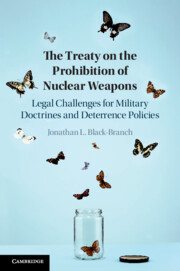 The Treaty on the Prohibition of Nuclear Weapons
The Treaty on the Prohibition of Nuclear Weapons Published online by Cambridge University Press: 17 April 2021
The TPNW was welcomed at the UN General Assembly, under the participation of a wide range of humanitarian groups and civil society organizations, supported by a groundswell of nations around the world. The Treaty firmly implants new law into the international legal landscape for states who wish to ratify it, sowing the seeds of potentially new normative behavior within the global community more generally. Indeed, the TPNW purports to strive for universality, raising significant questions regarding its ambitions in achieving legal unity within the wider international legal order. The dedication to the spirit of the Treaty cannot be ignored, nor can the optimism to ban nuclear weapons.
To save this book to your Kindle, first ensure [email protected] is added to your Approved Personal Document E-mail List under your Personal Document Settings on the Manage Your Content and Devices page of your Amazon account. Then enter the ‘name’ part of your Kindle email address below. Find out more about saving to your Kindle.
Note you can select to save to either the @free.kindle.com or @kindle.com variations. ‘@free.kindle.com’ emails are free but can only be saved to your device when it is connected to wi-fi. ‘@kindle.com’ emails can be delivered even when you are not connected to wi-fi, but note that service fees apply.
Find out more about the Kindle Personal Document Service.
To save content items to your account, please confirm that you agree to abide by our usage policies. If this is the first time you use this feature, you will be asked to authorise Cambridge Core to connect with your account. Find out more about saving content to Dropbox.
To save content items to your account, please confirm that you agree to abide by our usage policies. If this is the first time you use this feature, you will be asked to authorise Cambridge Core to connect with your account. Find out more about saving content to Google Drive.